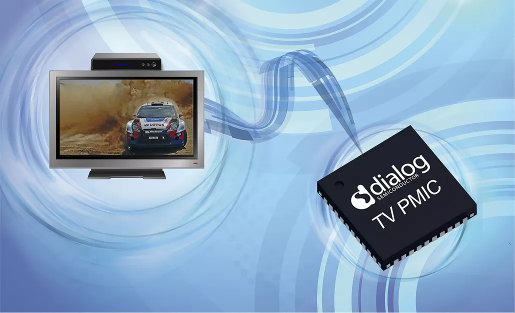Dialog Semi offers power management ICs for STBs and Smart TVs
Wednesday, February 3rd, 2016Dialog Semiconductor Expands Power Management Market with Industry’s first PMICs for Smart TVs and Set-top Boxes
- Highly integrated power management technology using proven smartphone concepts now extended to digital TV, STB and streaming media applications
LONDON, United Kingdom — Dialog Semiconductor plc (FWB:DLG), a provider of highly integrated power management, AC/DC power conversion, solid state lighting (SSL) and Bluetooth® Smart technology, today announced that the company is entering the smart TV and set-top box (STB) market with a family of highly integrated power management ICs (PMICs) that leverage its power management leadership in smartphones and tablet computing. Dialog is currently sampling three PMICs for low to high-end smart TVs to major OEMs. The devices were developed in partnership with TV System-on-Chip (SoC) vendors and have been proven in several reference designs.

Jalal Bagherli, CEO of Dialog, said, “Dialog invented the high integrated configurable PMIC concept for smartphones, tablets and other portable devices and we lead the market today. We have now adapted the concept to the power architecture of TVs and the resulting PMICs will radically change for the better how the TV analog power path will be designed going forward. There has been an absence of analog innovation in TVs for years, something that we’re changing with this new generation of products. The technology is based on our heritage of mobile market success and we will once again deliver compelling benefits to consumer product manufacturers.”
According to analyst Gartner, over 550 million TVs and STBs will be made in 2017. Increasing demand for high definition (4K) televisions is driving TV sales growth and the STB market is experiencing particularly rapid expansion in India and China. In addition, the advent of media streaming services such as Netflix, Hulu and Amazon TV has created new products such as video streaming sticks and personal media boxes in which the new PMICs may also be used.
Costs savings will be achieved because one PMIC will replace up to 130 discrete components typically found in a TV today. As a result, printed circuit boards can be simpler and less expensive. Pick-and-place assembly will be up to three times faster, cutting manufacturing costs, and by standardizing the analog power path with a few programmable power management devices across a wide range of applications, manufacturers will reduce both R&D and inventory costs.
The power requirements of SoC devices in TVs and STBs are becoming more complex as video processing technology advances. The processors require precise, highly efficient power supplies with dynamic voltage scaling and low ripple and noise, the latter to ensure improved picture stability. Using Dialog PMICs guarantees system cost reduction, improved power efficiency, enhanced performance and greater reliability.
Compared with power management designs that use discrete components, greater efficiency will deliver energy savings of up to 5 watts. Less heat needs to be dissipated, resulting in increased reliability, which is further enhanced because there are fewer components and connections. Designs will be simplified because the PMICs enable centralized control of the whole TV or STB power path. In addition the regulatory requirements around the world are pushing for lower standby power dissipation, typically below 300mW, which can be readily met using a PMIC-based system design.
Samples of Dialog’s TV PMICs are available now and the company will be ramping to high volume production in the second half of this year.
Latest News
- Interactive TV news channel unveiled by ROXi and Sinclair
- Spideo and OTTera unveil personalisation collaboration at NAB Show 2024
- Amagi integrates Intertrust DRM for FAST services
- Vantiva has shipped 22 million Android TV set-top boxes
- Newsmax launches subscription-based app with 24i
- Slovak Telekom and T-Mobile CZ upgrade video streaming with 24i